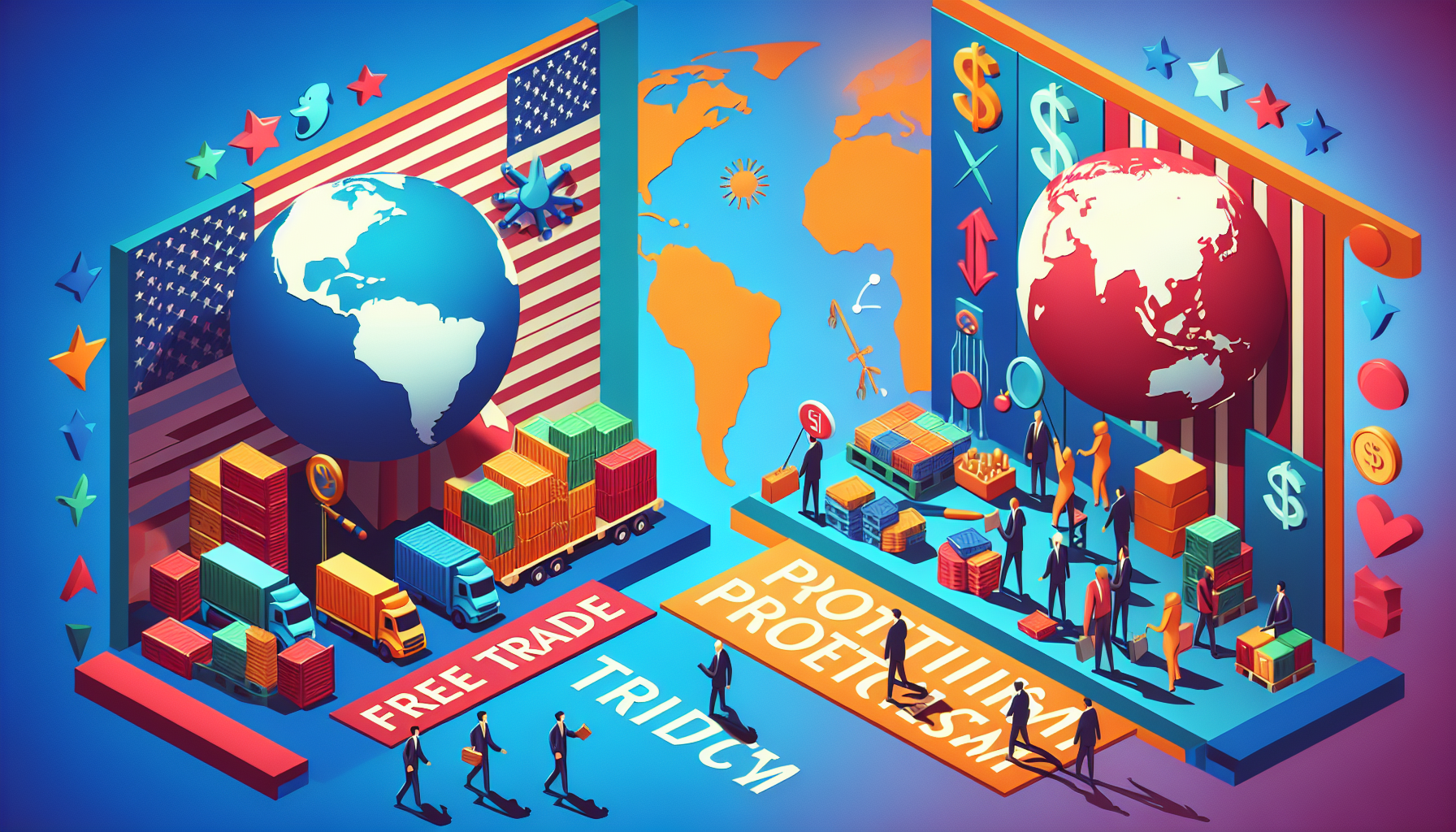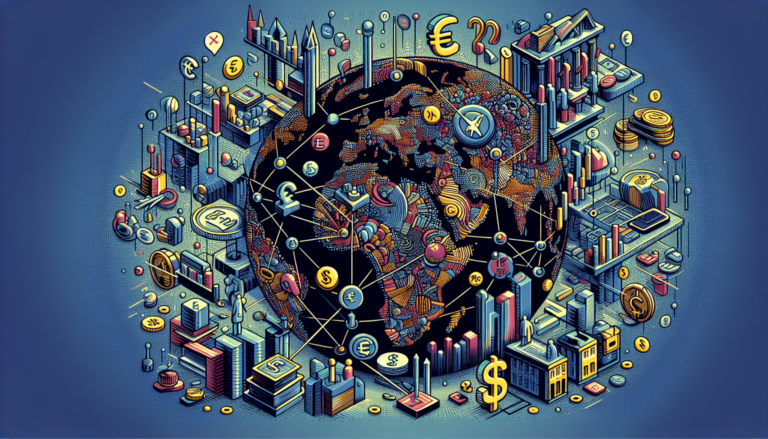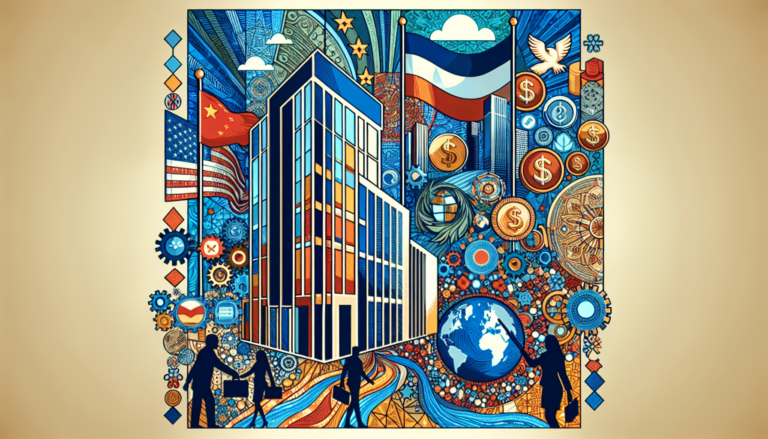Choosing Sides: Delving into the Economics of Free Trade vs. Protectionism

Understanding Trade Policies
Before diving into the economics of free trade vs. protectionism, it’s crucial to define these terms and comprehend their implications in international finance.
Defining Free Trade
Free trade is a trade policy that promotes unrestricted economic transactions between countries. It aims to eliminate barriers such as tariffs, quotas, and subsidies, fostering an open and competitive global market. Under free trade, countries can exchange goods and services with minimal government control or interference. The premise of free trade is that it can spur economic growth by allowing the most efficient producers to thrive, leading to lower prices for consumers, a broader selection of goods, and increased efficiency. For more information on how free trade impacts international finance, visit our article on the fundamentals of international trade.
Defining Protectionism
On the other side of the spectrum lies protectionism, a policy that involves using measures such as tariffs, quotas, and subsidies to protect domestic industries from foreign competition. While this approach can distort markets and lead to higher prices for consumers, it’s often justified on the grounds of preserving jobs, protecting industries crucial for national security, and shielding local businesses from unfair competition.
However, protectionism has its downsides. While it may shield certain industries in the short term, it can stifle innovation and competitiveness in the long run. By preventing foreign competition, industries may become complacent and less efficient, hindering economic progress and the overall welfare of a country’s citizens. For a deeper understanding of how protectionism affects the economy, refer to our article on the impact of tariffs and trade barriers.
As we explore the economics of free trade vs. protectionism, it’s important to keep in mind that these are not binary choices but rather points on a spectrum of trade policies. Nations often employ a mix of both strategies based on their economic goals and the needs of their domestic industries. The challenge lies in striking the right balance to ensure long-term economic health and stability.
The Impact of Trade Policies
Unfolding the complexities of trade policies, we delve into the economic implications of both free trade and protectionism. With careful consideration, policy makers must strike a balance between domestic industrial interests and the broader economic benefits of global competition.
Economic Effects of Free Trade
Free trade, as defined by the absence of tariffs, quotas, and other governmental trade barriers, can have significant economic benefits. By promoting competition, free trade can lead to lower prices for consumers due to increased efficiency and innovation.
The implementation of free trade agreements, which aim to eliminate or reduce trade barriers between countries, can stimulate economic growth and offer consumers a wider variety of goods. Moreover, free trade can enable countries to specialize in industries where they possess a comparative advantage, promoting efficiency and economic growth.
Additionally, free trade agreements can result in increased exports, economic growth, and job creation in participating nations. They can also lead to a more efficient allocation of resources, resulting in increased productivity and optimal economic welfare.
Economic Effects of Protectionism
Contrarily, protectionism, characterized by government-imposed policies to restrict international trade, can have mixed impacts on an economy. While it might safeguard domestic industries and jobs in the short term, it may also stifle innovation and lead to reduced competitiveness in the long run.
Protectionist measures, such as tariffs and subsidies, can protect domestic industries from international competition. Although this may shield jobs initially, it can also lead to reduced efficiency and competitiveness over time. Similarly, protectionist policies can promote local production, but they can also lead to retaliation by other countries, potentially triggering trade wars that can harm both domestic and international economies (Corporate Finance Institute).
Furthermore, protectionism can lead to higher prices for consumers due to limited competition and higher costs of production. It may also limit the benefits of specialization and hinder a country’s overall economic potential (Unstop).
Understanding these multifaceted economic impacts of free trade and protectionism is vital for grasping the broader dynamics of international trade and finance. To dig deeper into the complexities of the global financial system, explore topics such as global supply chains and finance, the balance of payments, and the future of globalization.
Case Studies in Trade Policies
Trade policies have a significant impact on global economics. In this section, we’ll explore some case studies on free trade agreements and protectionist measures to better understand their pros and cons.
Free Trade Agreements: Pros and Cons
Free trade agreements aim to eliminate or reduce trade barriers like tariffs and quotas between countries, promoting the free flow of goods and services. This can lead to an increase in overall economic growth and a larger variety of goods for consumers.
These agreements can create a more efficient allocation of resources by allowing countries to specialize in goods and services they can produce most effectively, leading to increased productivity and economic welfare.
Furthermore, free trade benefits consumers by providing a wide variety of goods at competitive prices, contributing to higher standards of living.
However, free trade can also increase market competition, which may result in job losses in industries that are unable to compete effectively in the global market.
For more insights on the impact of free trade agreements, you can refer to our article on international trade agreements and their effects.
Protectionist Measures: Pros and Cons
Protectionism, on the other hand, can lead to inefficiencies and suboptimal resource allocation in the long term.
Moreover, protectionist measures can lead to higher prices for consumers due to limited competition and higher costs of production (Corporate Finance Institute).
Despite these downsides, protectionist measures are often implemented to shield domestic industries from foreign competition and prevent job losses. However, these measures may not always achieve the desired results and could lead to economic inefficiencies in the long run.
For a deeper understanding of the impact of protectionist measures, you can refer to our article on the impact of tariffs and trade barriers.
In summary, both free trade agreements and protectionist measures have their pros and cons, and the impact of these trade policies can vary greatly depending on various factors such as the specific industries involved, the countries’ economic conditions, and the existing trade relationships. As such, it’s crucial to have an understanding of the economics of free trade vs. protectionism to make informed decisions in the realm of international trade and finance.
Trade Policies and the Global Economy
The economics of free trade and protectionism not only have domestic implications but also significantly affect the global economy. These impacts can be best understood by examining their effects on global value chains and international relations.
Global Value Chains and Trade Policies
Trade policies play a crucial role in shaping global value chains, which refer to the complex series of activities involved in producing a product or service and delivering it to consumers. These activities often span across multiple countries, forming interconnected webs of production and distribution.
According to Council on Foreign Relations, the implementation of tariffs by the United States and China has not only impacted trade flows and economies of both countries, but it has also disrupted global value chains, affecting the global economy. Such disruptions can result in increased production costs, delays, and uncertainty for businesses operating in these chains. To learn more about global value chains and their relevance to international finance, you can visit our article on global supply chains and finance.
On the other hand, free trade agreements can significantly streamline global value chains by reducing trade barriers and harmonizing regulations. For instance, the Comprehensive and Progressive Agreement for Trans-Pacific Partnership (CPTPP) and the European Union’s single market strive to promote economic integration between countries, facilitating smoother trade flows and fostering cooperation among member countries.
Trade Policies and International Relations
Trade policies also have far-reaching implications for international relations. According to the Government of Canada, free trade agreements can have broader impacts on diplomatic relations, security, and governance. They have been found to significantly reduce the likelihood of conflict between countries by increasing the cost of conflict and providing resolution mechanisms.
Conversely, protectionist measures such as tariffs can lead to retaliatory actions by other countries, resulting in trade wars that harm economic growth and disrupt global supply chains. For example, the U.S.-China trade war that began in 2018 led to increased tariffs on billions of dollars worth of goods, impacting various industries.
While protectionism might shield certain industries temporarily, it can stifle innovation and competitiveness in the long run. By preventing foreign competition, industries may become complacent and less efficient, ultimately hindering economic progress and the overall welfare of a country’s citizens. To get a deeper understanding of the implications of trade policies on international relations, you may want to explore our articles on international trade agreements and their effects and the impact of tariffs and trade barriers.
In conclusion, trade policies not only influence domestic industries but also have profound implications for the global economy and international relations. As the world becomes more interconnected, the effects of these policies are likely to become even more significant in the future. For more on this, visit our article on the future of globalization and international finance.
Trade Policies and Domestic Industries
Trade policies, whether leaning towards free trade or protectionism, carry significant implications for domestic industries. The impact on job creation and innovation are particularly noteworthy, as these areas directly influence the economic health of a nation.
Job Creation and Trade Policies
The impact of free trade versus protectionism on employment is a central issue in the debate. Proponents of free trade argue that it can lead to job creation by opening up new markets and promoting economic growth. Free trade enables domestic companies to expand their reach to international markets, potentially leading to increased demand and subsequently, job creation.
On the other hand, protectionists argue that free trade can lead to job losses as companies move production overseas to take advantage of lower labor costs. Protectionist policies, such as tariffs and quotas, can shield domestic industries from foreign competition, protecting jobs and industries that might otherwise be threatened by lower-cost imports. However, these measures can also lead to higher prices for consumers and reduced competitiveness for domestic producers in the global market (Investopedia).
Protectionist policies such as tariffs can protect domestic industries, promote local production, and safeguard jobs. However, they can also lead to retaliation by other countries, resulting in trade wars that can harm both domestic and international economies.
Trade Policies and Innovation
Protectionist measures, such as tariffs and subsidies, are often employed to shield domestic industries from international competition. While this may protect jobs in the short term, it can also stifle innovation and lead to reduced competitiveness in the long run.
When domestic companies are shielded from international competition, they may lack the incentive to innovate and improve. Over time, this can lead to a decline in the quality of their products and services, making them less competitive on the global stage. Conversely, exposure to international competition under free trade can pressure companies to continuously innovate in order to remain competitive.
In conclusion, the economics of free trade versus protectionism are complex and involve various factors, including the comparative advantage of countries, the impact on domestic industries and jobs, and the overall economic welfare of nations. Policymakers must carefully consider these factors when determining the appropriate trade policies for their countries.
For more information on the intricacies of international trade and finance, visit our articles on fundamentals of international trade, the balance of payments explained, trade finance: instruments and methods, and the role of multinational corporations in global finance.
Future of Trade Policies
As we navigate the complex world of international finance and trade, it’s essential to reflect on ongoing negotiations and predicted trends. These elements will shape the future landscape of trade, directly influencing the economics of free trade and protectionism.
Ongoing Trade Negotiations
Trade negotiations have been a staple of international economic discourse since the creation of the General Agreement on Tariffs and Trade (GATT) in 1947-48. Since then, there have been eight rounds of negotiations, with a ninth round, the Doha Development Agenda, currently ongoing. These negotiations initially focused on lowering tariffs on imported goods. By the 1980s, the negotiations expanded to address non-tariff barriers on goods, as well as areas such as services and intellectual property (WTO).
For instance, the United States has comprehensive free trade agreements in force with 20 countries (USTR). Meanwhile, Canada’s free trade agreements (FTAs) cover 61% of the world’s GDP, opening markets to 1.5 billion consumers worldwide and making Canada the only G7 economy with comprehensive free trade access to the entire G7 and European Union.
Predicted Trends in Trade Policies
Predicting the future of trade policies is a complex task, as it involves considering a multitude of factors, from domestic political climates to international relations. For instance, in the US, President Biden’s vision for higher and more complicated taxes could have implications for free trade and protectionism (Tax Foundation).
As per Canada’s experience, the impact of free trade agreements on the economy is evident. Bilateral trade more than doubled in the 10 years following the entry into force of Canada’s FTAs that were signed before 2010. For example, the 1997 Canada-Chile FTA increased bilateral trade 12.2% faster than would have been the case without the agreement (Government of Canada).
As we move into the future, it’s crucial to monitor these trends and understand their potential impacts on global and domestic economies. For a deeper dive into the fundamentals of international trade, explore our articles on the balance of payments explained and the impact of tariffs and trade barriers. For an overview of international finance, check out the global financial system: structure and players and foreign direct investment (fdi) trends and strategies.





